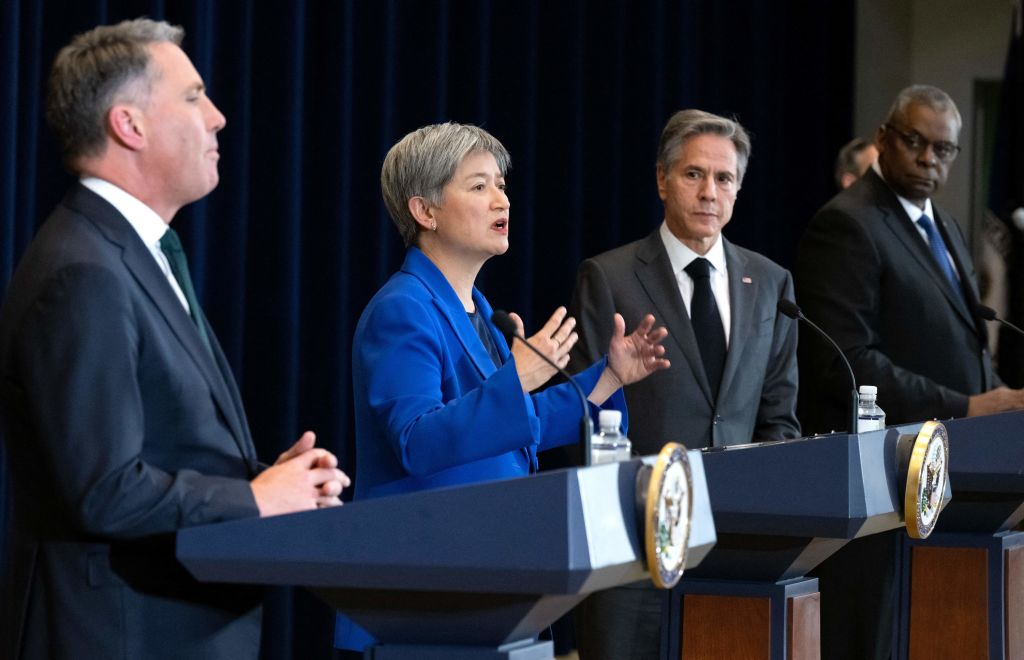
AUSMIN 2022 in Washington was a case of nothing much to hear but more to see. In contrast to recent years, the Australian delegation said little publicly on China but, consistent with its two-track China strategy, reinforced foreign and defence policies designed to protect the national interest from Beijing’s aggressive actions. The major announcement—inviting Japan to join ‘force posture initiatives’, in which US military personnel and assets rotate through northern Australia, didn’t mention China—but was all about China.
The integration of a very close strategic partner into such a potent demonstration of regional military co-operation under the Australia–US alliance adds to the clear picture that like-minded nations are now openly looking to constrain China—including through military deterrence.
This reality sits unavoidably alongside the positive vision espoused publicly at AUSMIN—with the alliance taking a leaf out of the successful Quad playbook which aims to build an ambitious narrative of opportunity for an Indo-Pacific that remains nervous about the risks of great-power competition.
For Australia’s part, maintaining a steady path of action enables the Albanese government to temper the rhetoric towards China. Foreign Minister Penny Wong kept her public remarks low-key, even when given the opportunity to welcome US support for Australia’s resilience to Beijing’s economic coercion.
This quieter tone was no doubt noticed in capitals watching—in particular Tokyo, Delhi and Beijing. So long as there is strength through policy, Tokyo and Delhi will understand quieter diplomacy is a reasonable strategy to appeal to nations in Southeast Asia and the Pacific, focusing on opportunities more than threats.
Through an emphasis on climate, multilateralism, and regional needs such as humanitarian response, Australia and the US are encouraging Indo-Pacific countries to join a positive vision.
Defence Minister Richard Marles, notwithstanding the moderation in language on China, described the force-posture invitation to Japan as ‘providing balance within our region and involving other countries within our region’—an implicit acknowledgement that a free and open region will depend on countries working together to balance China’s ambition to be the pre-eminent power. That is the reality.
Provided there is a continuation of substantive policies to counter Beijing’s worst behaviour, this dual track of firm action and mild language should be a sound approach. The question is whether this duality is a viable long-term strategy. A measured tone cannot be inaudible in the face of aggression. Silence—even if accompanied with policy—inevitably incentivises more, not less, malice.
Getting the balance right is essential—while there is regional aversion to tension, success will rely on confidence that the US and its partners, including Australia, will be there for the region’s needs. Confidence, above all, is what the region wants and what Beijing aims to erode.
The job ahead is to continue knitting together the fabric of confidence-building partnerships. The Biden administration’s enthusiasm is evident, as we saw when Secretary of State Antony Blinken used AUSMIN to re-emphasise US priorities on alliances.
For Australia, Japan has been the standout relationship of 2022 in practical terms, with a joint declaration on security co-operation signed during Prime Minister Fumio Kishida’s visit in October, and the force posture announcement at AUSMIN which was followed up quickly by a 2+2 foreign and defence ministers’ meeting in Tokyo on Friday.
The relationship would be enhanced even further if Japan were invited to work more closely with the non-submarine pillar of AUKUS, as Marles suggested it could ‘when ready’. This fits well with Marles’ post-AUSMIN observation that like-minded countries whose defence industries have traditionally competed need to focus instead on cooperation, ‘given the strategic circumstances that the world finds itself in now’.
The late former Japanese prime minister Shinzo Abe called for Japanese involvement in AUKUS and just last month, Ambassador Shingo Yamagami said that ‘Japan stands ready to discuss with Australia, the US and the UK areas where we can cooperate bilaterally on defence technology’.
The Quad, while still a work in progress, remains the most promising action-oriented Indo-Pacific vehicle. It featured heavily in the AUSMIN communiqué, which talked about a ‘positive and practical agenda’ to ‘respond to the region’s needs’, including on maritime domain awareness, critical technology, climate and health security.
With India taking on the G20 presidency and Australia hosting the 2023 Quad leaders’ meeting, we can expect Australia to continue growing closer to India, including in defence. Notwithstanding some difference over Russia, there is strategic alignment between these four major Indo-Pacific democracies that makes the Quad indispensable.
Indeed, 2023 could be Australia’s year for India in the way that 2022 was its year for Japan. India has the potential to be the most important regional country (outside the US) to help with the strategic balancing of a rising China. Beijing would ideally like Delhi to only ever have potential while it is in Australia’s interests to support India realise it.
As a trusted US ally, a member of the Five Eyes, the Quad, AUKUS and the Pacific Islands Forum, and an ASEAN partner, Australia is uniquely placed to simultaneously project a positive regional vision and contribute to the actions necessary to deter China and maintain regional stability and sovereignty.

